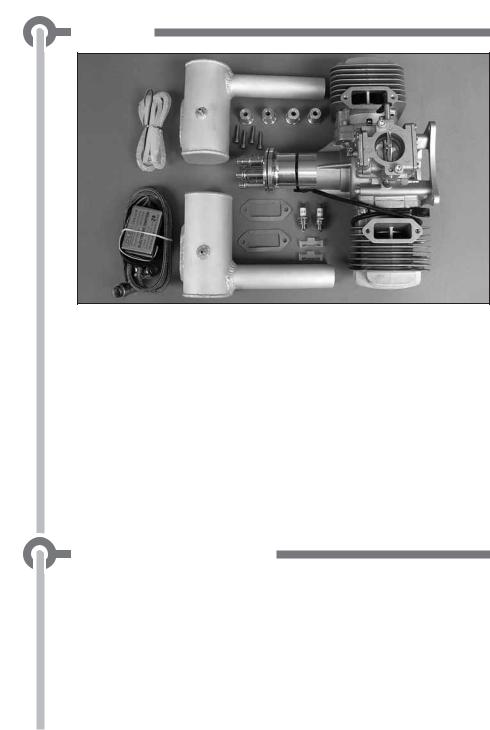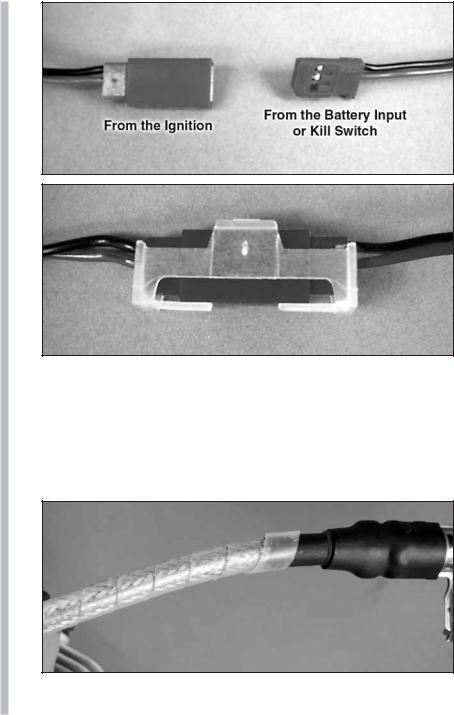DLE 170 User Manual

DLE-170
Operator’s Manual
|
|
|
|
Specifications |
|
|
|
|
|
|
|
|
|
|
|
|
|
Displacement: 170cc [10.37 cu. in.] |
||
|
|
|
|
Performance: |
17.5 HP/ 9,000 RPM |
|
|
|
|
|
Idle speed: |
1,100 RPM |
|
|
|
|
|
Ignition Style: |
Electronic Ignition |
|
|
|
|
|
Recommended Propellers: |
30u12, 32 u10 |
|
|
|
|
|
Spark Plug Type: CM6 |
||
|
|
|
|
|
|
(Gap) 0.018 in. – 0.020 in. [0.45 mm – 0.51mm] |
|
|
|
|
Diameter x Stroke: |
2.06 in. [52mm] u1.19 in. [ 30 mm] |
|
|
|
|
|
Compression Ratio: |
9.5:1 |
|
|
|
|
|
Carburetor: |
(1) DLE with Manual Choke |
|
|
|
|
|
Weight: Main Engine − 7.83lbs [3,552 g] |
||
|
|
|
|
|
|
Mufflers (2) − 13.8 oz [391 g] |
|
|
|
|
|
|
Electronic Ignition (1) − 5.2 oz [148 g] |
|
|
|
|
|
|
Engine Mount Standoffs (4) − 1.4 oz [41g] |
|
|
|
|
|
Fuel: 87− 93 Octane Gasoline with a 30:1 |
|
|
|
|
|
|
|
gas/2-stroke (2-cycle) oil mixture |
|
|
|
|
™ |
|
|
1 |
|
|
© 2010 Hobbico®, Inc. |
DLEG0170 Mnl |
||
|
|
|||||

Parts List
(1)DLE-170cc Gas Engine w/ DLE carburetor
(2)DLE (CM-6 size) Spark plugs
(2) Mufflers w/(2) gaskets
(4) 5x20mm SHCS (muffler mounting)
(1)Electronic Ignition Module w/additional tachometer lead
(4)20mm Engine Mounting Standoffs
(6)6x55mm SHCS with 6mm lock washers & 6mm flat washers (propeller mounting)
(2)Silicone Pick-up Wire Cover/Ignition Wire Cover
(1)Red Three Pin Connector Lead w/ Pig Tail (ignition switch)
(2)Three Pin Connector Securing Clips
(1)DLE-170 Decal Sheet
(2)Brass Pressure Fittings (smoke system use/not included)
Safety Tips and Warnings
●This engine is not a toy. Please place your safety and the safety of others paramount while operating. DLE will not be held responsible for any safety issues or accidents involving this engine.
●Operate the engine in a properly ventilated area.
●Before starting the engine, please make sure all components including the propeller and the engine mount are secure and tight. It is strongly recommended that a screw sealant is used (Great PlanesThreadlocker GPMR6060) during engine installation.
●During the break-in period, it is recommended that the engine be installed on the aircraft or a test stand with an appropriate shock
2

absorber. Otherwise it is probable that vibration could rebound back to the engine and serious damages may occur during the break-in period.
●For your safety and the safety of others, please do not stand in front or in line with the propeller when the engine is running. Keep onlookers away from the running engine, especially small children.
●Always use a balanced spinner and a balanced propeller. An unbalanced spinner and/or propeller combination will cause high levels of vibration and may cause the propeller shaft to break. Always use a high-quality lightweight spinner on your engine. Lightweight spinners are considered to be those with a cone wall of 1mm or less. Heavy spinners could cause the propeller shaft to break. Securely tighten the spinner and propeller on the engine to prevent them from being thrown off while running.
●Never use a propeller that has impacted the ground. Even though it may look good from the outside, it may have internal damage which could cause it to disintegrate while in use. Do not use a nicked, cracked or split propeller.
●Keep foreign objects away from the propeller. Make sure that nothing can be “sucked in” by the propeller.
●Never start the engine on loose gravel or sand.
●Do not attempt to stop the engine by throwing anything into the path of the propeller.
●Make sure the fuel line is well-secured to the engine and to the fuel tank so that it won’t come off in flight.
●Do not use silicone fuel line because it will be dissolved by the fuel. Use only gasoline approved rubber fuel line. Always secure the fuel line away from the cylinder head.The engine’s heat can damage the fuel line.
●Never touch the engine or muffler immediately after a run.The engine will be hot.
●Before transporting your model, remove all the fuel from the fuel tank and fuel lines.
●Always use high-quality oil intended for 2-stroke (2-cycle) engines. It's a good idea to use a petroleum-based 2-cycle motor oil like Lawn Boy All Season - Ashless, Generation II oil for the break-in period. Break-in should be considered about the first 3-5 gallons you run in the engine. A high quality synthetic 2-cycle oil is recommended for optimum performance and a longer engine life. Synthetic 2-cycle oils leave fewer combustion byproducts than natural oils, which can foul the engine and exhaust ports,
|
resulting in reduced performance. Synthetic oils also better |
3 |
reduce friction and provide more fluidity at low temperatures. |

●For optimum performance please use fresh or recently purchased 87 octane gasoline with a 30:1 gas/oil mixture.
GAS/OIL Mixing Guide
1 Gallon Gasoline (128 fl oz/3.78L)/2-Cycle Oil
(4.26 floz/125.68ml)=30:1 ratio
●Always install an ignition system kill switch on the aircraft used.
●Do not install your throttle servo or kill switch servo inside the engine compartment. Doing so could cause radio interference. Install all electronic radio devices at least 12" [305mm] away from the engine.
●The throttle and choke pushrods should be non-metallic.
●If the engine is not to be used for more than a month, drain the fuel tank and remove any fuel from inside the carburetor. Do this by running the engine at idle until it quits by running out of fuel. Keeping gasoline inside the carburetor over an extended period of time will damage the diaphragm valve and clog passages inside the carburetor. Due to the carburetor being more complicated than those used in glow engines, keep the fuel clean by using an on-board fuel filter. Use a filter intended to be used with gasoline engines. Metal filters intended for glow engine are too coarse and will not screen out finer particles.
●Always filter your fuel by using an appropriate filter before putting it into the airplane’s fuel tank.
●Gasoline is extremely flammable. Keep it away from an open flame, excessive heat or sources of sparks.
●Do not smoke near the engine or the fuel tank.
●This engine was designed for use in a model aircraft. Do not attempt to use it for any other purpose.
●Caution: Running the engine with a lean gas mixture will cause the engine to overheat and burn the electrode of the spark plug. Pay close attention to the High-speed Needle adjustment. Running the engine with the proper gas mixture will cause the spark plugs to appear slightly yellow at the ignition point.
●Excessive running of the engine at idle speed can result in seriously carbonized spark plugs.
●Keep the surface of the engine clean to ensure proper heat dissipation. Ensure proper cooling/ventilation around both cylinders with adequate air exhaust. A 1:3 ratio of air intake to
4 |
air exhaust is recommended for proper engine cooling. |

●To avoid permanent damage to the electronic ignition system, NEVER rotate the propeller on your DLE engine with the electronic ignition system switched on and the plugs not installed in the plug caps.
●If you elect to not use a smoke system with your engine and aircraft, the two included brass fittings must be installed in the muffler and then obstructed to prevent exhaust from leaking into the cowling.To do this use two short segments of neoprene fuel line and two (GPMQ4166) fuel-line plugs (not included).
Installation Instructions
Prepare the Engine for Installation
Before beginning installation, it’s a good idea to plan the location of the various components of the engine. Many of the following steps may need to be completed in a different order than listed.
1. Check to see that all screws and bolts are tight. Check carefully for any cracks, broken or missing parts.Tighten or replace any damaged or missing parts before proceeding.
2. Install the silicone wire cover over the pick up lead coming from the engine (cut the excess silicon wire covers) and connect the lead to the pick–up lead from the Electronic Ignition Module. Secure the connection with the included three pin connector securing clip.
5

3.Connect the ignition kill switch lead to the red connector from the ignition control module using the lead from the kill switch or with the included three pin connector with pig tail. Use the included three pin securing clip to secure the connection.
4.Connect the ignition module battery to the kill switch. Any 4.8- 6.0V, 1000mAh and above capacity battery will work well for this. Use heat shrink tubing to secure this connection.
|
5. Install the silicone ignition wire cover over the ignition wires to |
|
the spark plugs. |
6 |
6. Install the spark plugs into the engine cylinders (7-8lbsTorque). |
